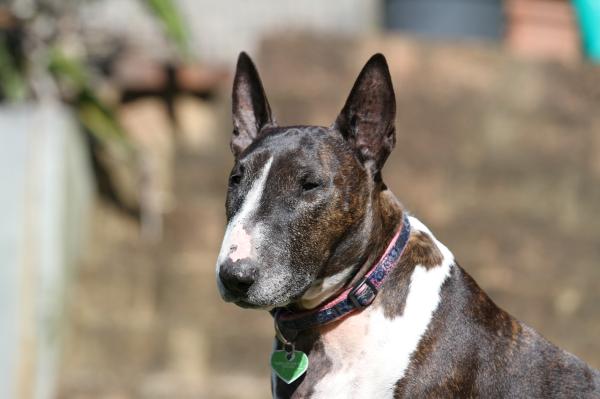
The English Bull Terrier is a very sweet and special dog with a unique appearance. If you're considering adopting a dog from this wonderful breed, you should first do your best to learn how to care for them correctly. This way, your future Bull Terrier will become a friendly, stable and happy adult dog.
This AnimalWised article will go over the usual behavior and traits of the English Bull Terrier and will share some guidelines and tips on their training. Remember that training a dog, regardless of their breed, is not as simple as it seems. You will need patience and knowledge to respond to the challenges you will encounter.
Want to discover our tips to train a Bull Terrier? Read on!
Origin and history of the Bull Terrier
All dogs, no matter their breed, belong to the same subspecies: Canis lupus familiaris. In general, dogs are social animals that need to live in groups, but have been domesticated by humans across the centuries. Nowadays, a dog's pack can be their human family.
There are many ways to classify dogs into types and groups. One of them is their function: Bull Terriers were originally bred in the UK to hunt vermin, as they were both agile and quick, and occasionally to herd cattle. Unfortunately, English Bull Terriers were also bred to be used in dog fights and other horrifying blood spectacles. Over the generations, Bull Terriers became very strong dogs, known for their bravery and tenacity. They also developed a tendency to lock the bite; when they bite, they can maintain their hold for a long time.
Eventually, Bull Terriers began to be accepted as pets instead of working dogs and breeders began to soften those behavioral traits. Modern English Bull Terriers hardly retain any of that old ferocity; however, they have kept other, more desirable features, and have become highly valued dogs.

What are Bull Terriers like?
The English Bull Terrier breed retains certain qualities from its history as a hunting dog, including a remarkable personality. In general, Bull Terriers can find it difficult to get one with other dogs. However, early positive socialization should correct any negative behavior in this way. They are stubborn, but bond well with their human family and can be quite protective. Although they are unlikely to yap and bark, they are generally wary of strangers. One they bond with their family, they can be very affectionate. Bull Terriers can be good with children, but they need to be well-socialized. Their energy and playfulness is not always ideal for very young children.
You need to keep in mind that these traits vary greatly from dog to dog; some Bull Terriers may be completely different. The best way to help control behavioral problems in Bull Terriers is to have them sterilized. It helps to give them an even temperament and has many other health advantages. Bull Terriers are wonderful companions, but their stubbornness and care requirements means they are only suitable for experienced and active dog owners.

Training a Bull Terrier
Before adopting a dog, you must take into account the characteristics of each breed. Will a Bull Terrier suit your family, your working hours and your economic situation? There are no magic tricks when it comes to training dogs, so you must be realistic. If you suspect training a Bull Terrier will take a time you don't have, you should consider a breed for beginners.
If you have decided that an English Bull Terrier is the dog for you, the first thing you should do is to ensure it is well socialized. Socialization is a long process, and it should be started while the young Bull Terrier puppy is still with their mother. It's easier to train dogs when they are adopted at 6 to 8 weeks old.
Introduce your new Bull Terrier to many different people, animals and objects gradually and calmly so that they learn to behave in a friendly manner in the future and respond positively to their environment without showing fear or aggression.
As you do this, you should also start to house train your puppy. Your Bull Terrier needs to get used to regular meal times and their bedding area. At meal times, feed them some of the meal by hand. Remove all toys from the eating area and get the whole family involved with the feeding. The Bull Terrier should also get used to being alone to prevent problems associated with separation anxiety and destructive behaviors.
You should train your Bull Terrier by positive reinforcement, using rewards and praise and avoiding punishment at all costs. If you want your pet to acquire a certain behavior, reward them immediately when they do it and ignore any behaviors you want to avoid. For instance, when your Bull Terrier relieves themselves in the street, reward them with a treat. If your dog does their business in the home, ignore it completely.
Training a Bull Terrier is not a simple task because this breed does not always respond as well as other breeds. They will require more patience to train, but they can acquire basic dog commands with time. You can start obedience training from 6 months old with commands such as "sit", "here", "come" or "heel" when you go out for walks.
To do this, give the dog the order whilst making the associated gesture at the same time; the gesture must always be the same. Reward your dog each time they carry out a command correctly and help them with each new skill: for instance, gently press down the Bull Terrier's lower back when you teach them the "sit" order. Repeat the sequence until the dog learns to do it by themselves. Keep in mind that the training sessions must be short, starting with 5 minutes and never exceeding 20 minutes.

How much exercise do Bull Terriers need?
All dogs need daily physical exercise, which should vary according to their age and breed. Many behavioral problems can be avoided with a good walk and play session.
A puppy should to go for walks often, about twice as much as an adult. Adult Bull Terriers should go out for a walk 3 times a day; two of the walks should be short, at around 15 minutes, and one of them should take at least an hour.
Find out more about dog walks and make sure your new friend has plenty of exercise to keep them happy, calm and obedient.

These are our tips to train a Bull Terrier. What are yours? Share them in the comments section!
If you want to read similar articles to Tips to Train a Bull Terrier, we recommend you visit our Basic education category.